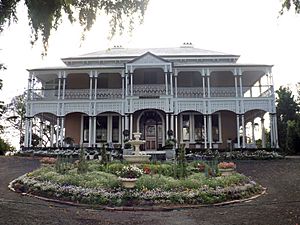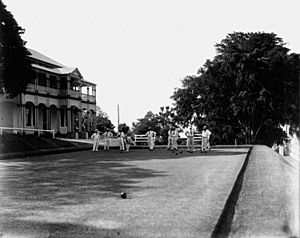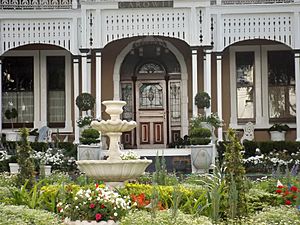Garowie facts for kids
Quick facts for kids Garowie |
|
|---|---|

Building in 2015
|
|
| Location | 59 Whitehill Road, Eastern Heights, City of Ipswich, Queensland, Australia |
| Design period | 1870s - 1890s (late 19th century) |
| Built | c. 1888 |
| Built for | James Clarke Cribb |
| Architect | Samuel Shenton |
| Official name: Garowie | |
| Type | state heritage (built, landscape) |
| Designated | 21 October 1992 |
| Reference no. | 600599 |
| Significant period | 1880s (fabric) 1880s-1920s (historical) |
| Significant components | fence/wall - perimeter, residential accommodation - main house, trees/plantings |
| Builders | Robert Wilson and Co |
| Lua error in Module:Location_map at line 420: attempt to index field 'wikibase' (a nil value). | |
Garowie is a grand old house, also known as a villa, located at 59 Whitehill Road in Eastern Heights, City of Ipswich, Queensland, Australia. It's a very special building because it's listed on the Queensland Heritage Register. This means it's an important historical place that needs to be protected. The house was designed by an architect named Samuel Shenton and was built around 1888 by Robert Wilson and Co.
Contents
A Look Back: Garowie's History
Garowie is a large, two-storey house. It was one of many big homes built on the high ground of Ipswich. The house was built for James Clarke Cribb and his wife Alice. James was the son of Benjamin Cribb, who started the famous business Cribb and Foote.
The house was designed by Samuel Shenton, a builder and architect from Ipswich. It was finished in 1888. People say Garowie was designed to look like another grand house called Gooloowan, which belonged to James's father.
The Architect: Samuel Shenton
Samuel Shenton arrived in Ipswich in 1851. He started as a carpenter and builder. He worked on many important buildings in Ipswich. By 1879, he became a full-time architect. He designed several notable buildings, including the Central Congregational Church Manse. Shenton was also very involved in his community. He served as an alderman and was even the Mayor of Ipswich twice. He passed away in Ipswich in 1893.
The Cribb Family and Garowie
James Cribb worked for his family's company until 1904. After that, he became involved in local and state government. He was a Member of the Queensland Parliament for 19 years. He also helped manage the Ipswich Hospital and other local businesses.
After James Cribb passed away in 1926, his brother Harry bought Garowie. Harry Cribb was a champion tennis player. Garowie used to have a tennis court on its grounds. In the mid-1920s, this tennis court was changed into a bowling green. Some parts of the property were later sold off, and other houses were built there. The original fence was replaced with a stone fence around this time.
Harry Cribb died in 1944, and the house was sold. During World War II, Garowie was divided into several smaller apartments.
Restoring Garowie's Beauty
In 1970, Dr. and Mrs. J. Thomas bought the house and started to restore it. Later, in the 1980s, Edwin and Loretta Stoyle lived there and raised their children.
In 2003, the Frank family bought Garowie. The house needed a lot of work. Many things were missing, like floor coverings and lights. The Frank family worked hard to restore the property. They fixed the foundations, replaced verandahs, and even rebuilt a back wall that had been damaged. They also installed new antique lights and improved the gardens.
Originally, Garowie was made of brick. Later, after 1919, it was covered with a cement render. The house once had a billiard room, which has since been moved. The decorative wooden patterns on the front porch are not the originals. They were copied from another house in Ipswich called Lakemba.
The name Garowie is believed to be an Aboriginal word. It means Fig Tree Camp.
Garowie's Design and Features
Garowie faces east, looking towards Whitehill Road. The house has a main brick structure covered in cement. It is surrounded by verandahs on both the ground and upper levels.
The lower verandah has strong, paired columns supporting it. It doesn't have a railing. Below the upper verandah, there's a decorative border of timber battens. The upper verandah has beautiful, detailed cast iron lace railings between its paired columns.
The house has a corrugated iron hipped roof. The roof over the upper verandah is slightly lower and curved. The main entrance, facing the street, has a central gabled portico with a fancy fretwork design. A decorative stone fence and many mature plants along the front of the property help to screen the house from the road.
Why Garowie is a Heritage Site
Garowie was added to the Queensland Heritage Register on 21 October 1992. This means it meets certain important standards.
Showing Queensland's Past
Garowie helps us understand how wealthy people lived in Ipswich in the late 1800s. It shows how important families, who were successful in Ipswich's businesses, built grand homes.
A Great Example of Architecture
Garowie is a wonderful example of a large Queensland house from the late Victorian era. Its old masonry fence also shows how big its original gardens were.
The house is also special because it's an example of the work of Samuel Shenton. He was one of the first important architects in Ipswich.
Its Beautiful Appearance
Garowie is a very striking and grand house. It adds a lot of beauty to the street with its well-kept gardens and its two-storey front. The iron-lace railings and the gabled entrance make it very decorative. Its large size and important location make it a landmark in the city.
Connected to Important People
Garowie has a special connection to the Cribb family. It was built as their family home, especially for James Clarke Cribb. He was important in both local and state government. The Cribb family has been very significant in Ipswich since the city was first settled. They were involved in business, politics, and education. They are most famous for their long-running department store, Cribb & Foote.



